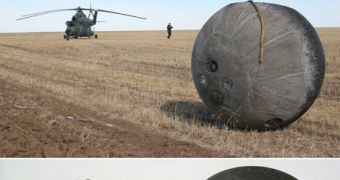We have been looking for Martians on Mars, for decades now, but we have not found them yet. Have we been looking in the wrong place during all this time? What if we were the actual aliens, Martians? Scientists, researching this possibility, sent fossilized microscopic life-forms into space and dropped it to simulate the fall of a natural meteorite, through the Earth's atmosphere to find if life could survive the trip.
Researchers from the European Space Agency created a baseball-size rock on which they attached biological material. The rock containing the fossilized microorganisms, was sculpted and placed to the exterior of the Foton M3 spacecraft, from rocks brought from Orkney Islands in northern Scotland. The spacecraft carrying 43 experiments, was launched by a rocket from Kazakhstan's Baikonur Cosmodrome, and after orbiting the Earth for 12 days, it re-entered the Earth's atmosphere on 26 September, and landed in Kazakhstan. After examining the remnants of the sphere that exploded at the impact with the surface, scientists have found that some of the biological material has survived the rough ride in the coldness of space, and through the high temperatures during re-entry.
This experiment confirms the previous predictions; the simple organisms can survive an interplanetary trip, and the fall to the surface of another planet. Previous experiments, involving theories about rocks that came from other planets, only studied the degree to which they melt during the entry in the atmosphere. The rock containing the experiment was measuring seven centimeters in diameter, and was fitter to the exterior of Foton M3.
The experiment has been shielded during the trip into space, and fully exposed when it fell back to Earth. Some of the experiments that were housed by the Foton M3 spacecraft involved measuring how much mass loss a meteorite that size would suffer during a re-entry. So to simulate the ideal conditions, the artificial meteorite had to have similar properties to a natural one, known as carbonaceous chondrite, which contains water and carbon compounds essential to life.
The size of the meteorite is a key feature, for simple organisms to survive the re-entry and the impact. Three-quarter of the mass of the original meteorite has disappeared, due to friction with the air, so living organisms could have not survived the trip as the core temperature reached about 200 degrees Celsius. A bigger rock, 20 centimeters across, would protect relatively well the organisms in its core, since heat would not penetrate so well to the middle. A much larger meteorite would also pose threat to living organisms traveling in it. It will pass with ease through the atmosphere, but the impact would probably vaporize the rest.
Panspermia is the theory that suggests that life is actually seeded by such meteorites, into neighboring planets like Earth. Microbes live on Earth in rock, up to a few kilometers down in the crust. Scientists think that Mars is the most likely source of life on Earth. A past collision of a meteorite or asteroid with Mars could have thrown into space a lot of debris containing pieces of its crust, that could possibly house life.
Studies show that about 5 percent of the meteorites blasted from the surface of Mars will eventually hit Earth. This journey from Mars to Earth could take somewhere from 15 million years, to less than a year, depending on their motion in space.
Although Mars looks now inhospitable to life, there is evidence that the Red Planet was warmer in the past, and could have had even liquid water on its surface, oceans or rivers. So far, there has not been life found on another planet, but the experiment showed that life could survive the interplanetary trip, and could possibly populate a planet.

 14 DAY TRIAL //
14 DAY TRIAL //